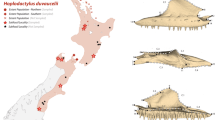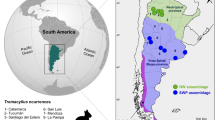Abstract
The mammalian fossil record is largely composed of isolated teeth and tooth-bearing elements. In vertebrate microfossil assemblages with closely related, co-occurring species of mammals, it can be difficult to identify isolated teeth to species level because morphological differences among species may be slight and based on a single tooth position. Here we investigate the utility of the allegedly diagnostic lower fourth premolar (p4) for species-level identification in the genus Mesodma (Multituberculata, Neoplagiaulacidae). We conducted linear and geometric morphometrics on 86 p4s representing four Cretaceous-Paleogene (K-Pg) species of Mesodma that are common in deposits of the western interior of North America. Although Mesodma has been extensively discussed in the literature, these four species overlap considerably in p4 size and shape, making species-level identifications challenging. Using linear measurements, landmarks, and semilandmarks, we quantified p4 size and shape to understand morphological variation across the genus and uncover practical sources of morphological differentiation among the species represented here. Our results indicate (1) size is more important than shape for identifying p4s of Mesodma species; p4 shape varies across the genus, but cannot be used alone to identify isolated p4s to species; (2) M. garfieldensis and M. thompsoni cannot be distinguished from each other using p4 size or shape; we therefore subsume M. garfieldensis within M. thompsoni; and (3) M. formosa increased in size across the K-Pg boundary. In light of these results, we recommend that taxonomic diagnoses relying on isolated teeth incorporate quantitative analyses of morphology whenever possible to increase the accuracy of species-level identifications and paleofaunal studies that employ them.






Similar content being viewed by others
References
Adams DC, Otárola-Castillo E (2013) geomorph: an R package for the collection and analysis of geometric morphometric shape data. Meth Ecol Evol 4:393–399
Archibald JD (1982) A study of Mammalia and geology across the Cretaceous-Tertiary boundary in Garfield County, Montana. Univ Calif Publ Geol Sci 122:1–286
Chew AE (2009) Paleoecology of the early Eocene Willwood mammal fauna from the central Bighorn Basin, Wyoming. Paleobiology 35:13–31. doi:10.1666/07072.1
Cifelli RL, Eberle JJ, Lofgren DL, Lillegraven JA, Clemens WA (2004) Mammalian biochronology of the latest Cretaceous. In: Woodburne MO (ed) Late Cretaceous and Cenozoic Mammals of North America: Biostratigraphy and Geochronology. Columbia University Press, New York, pp 21–42
Clemens WA (1964) Fossil mammals of the type Lance Formation, Wyoming: Part I. Introduction and Multituberculata. Univ Calif Publ Geol Sci 48:1–105
Clyde WC, Gingerich PD (1998) Mammalian community response to the latest Paleocene thermal maximum: an isotaphonomic study in the northern Bighorn Basin, Wyoming. Geology 26:1011–1014
Cope DA (1993) Measures of dental variation as indicators of multiple taxa in samples of sympatric Cercopithecus species. In: Kimbel WH, Martin LB (eds) Species, Species Concepts and Primate Evolution. Springer, New York, pp 211–237
Eberle JJ (2003) Puercan mammalian systematics and biostratigraphy in the Denver Formation, Denver Basin, Colorado. Rocky Mt Geol 38:143–169
Eberle JJ, Lillegraven JA (1998) A new important record of earliest Cenozoic mammalian history: geologic setting, Multituberculata, and Peradectia. Rocky Mt Geol 33:3–47
Flynn JJ, Wyss AR, Croft DA, Charrier R (2003) The Tinguiririca Fauna, Chile: biochronology, paleoecology, biogeography, and a new earliest Oligocene South American Land Mammal ‘Age.’ Palaeogeogr Palaeoclimatol Palaeoecol 195:229–259. doi:10.1016/s0031-0182(03)00360-2
Gingerich PD (1974) Size variability of the teeth in living mammals and the diagnosis of closely related sympatric fossil species. J Paleontol 48:895–903
Gingerich PD, Smith BH, Rosenberg K (1982) Allometric scaling in the dentition of primates and prediction of body weight from tooth size in fossils. Am J Phys Anthropol 58:81–100
Giraudoux P (2015) pgirmess: data Analysis in ecology. R package version 1.6.2. http://CRAN.R-project.org/package=pgirmess
Gould SJ (1975) On the scaling of tooth size in mammals. Am Zool 15:353–362
Gunz P, Mitteroecker P (2013) Semilandmarks: a method for quantifying curves and surfaces. Hystrix 24:103–109
Häärä O, Harjunmaa E, Lindfors PH, Huh SH, Fliniaux I, Åberg T, Jernvall J, Ornitz DM, Mikkola ML, Thesleff I (2012) Ectodysplasin regulates activator-inhibitor balance in murine tooth development through Fgf20 signaling. Development 139:3189–3199. doi:10.1242/dev.079558
Harjunmaa E, Kallonen A, Voutilainen M, Hamalainen K, Mikkola ML, Jernvall J (2012) On the difficulty of increasing dental complexity. Nature 483:324–327. doi:10.1038/nature10876
Hutchinson GE (1959) Homage to Santa Rosalia, or, why are there so many kinds of animals? Am Nat 93:145–159
Jernvall J, Keränen SVE, Thesleff I (2000) Evolutionary modification of development in mammalian teeth: quantifying gene expression patterns and topography. Proc Natl Acad Sci USA 97:14444–14448.
Lillegraven JA (1969) Latest Cretaceous mammals of upper part of Edmonton Formation of Alberta, Canada, and review of marsupial-placental dichotomy in mammalian evolution. Univ Kansas Paleontol Contr 50:1–122
Lofgren DL (1995) The Bug Creek problem and the Cretaceous-Tertiary transition at McGuire Creek, Montana. Univ Calif Publ Geol Sci 140:1–185
Maas MC, Anthony MRL, Gingerich PD, Gunnell GF, Krause DW (1995) Mammalian generic diversity and turnover in the late Paleocene and early Eocene of the Bighorn and Crazy Mountains Basins, Wyoming and Montana (USA). Palaeogeogr Palaeoclimatol Palaeoecol 115:181–207. doi:10.1016/0031-0182(94)00111-K
Mayr E (1970) Biological properties of species. In: Populations, Species, and Evolution: An Abridgment of Animal Species and Evolution. Harvard University Press, Cambridge, pp 37–54
Moustakas JE, Smith KK, Hlusko LJ (2011) Evolution and development of the mammalian dentition: insights from the marsupial Monodelphis domestica. Devel Dynamics 240:232–239. doi:10.1002/dvdy.22502
Novacek M, Clemens WA (1977) Aspects of intrageneric variation and evolution of Mesodma (Multituberculata, Mammalia). J Paleontol 51:701–717
Polly PD (1998) Variability in mammalian dentitions: size-related bias in the coefficient of variation. Biol J Linn Soc 64:83–99
R Core Team (2015) R: A language and environment for statistical computing. R Foundation for Statistical Computing, Vienna http://www.R-project.org/
Rohlf FJ (2013a) tpsDig, Version 2.17. Department of Ecology and Evolution, State University of New York, Stony Brook
Rohlf FJ (2013b) tpsUtil, Version 1.60. Department of Ecology and Evolution, State University of New York, Stony Brook
Rose KC, Bown TM (1986) Gradual evolution and species discrimination in the fossil record. Rocky Mt Geol 24:119–130
Sampson PD, Bookstein FL, Sheehan FH, Bolson EL (1996) Eigenshape analysis of left ventricular outlines from contrast ventriculograms. In: Marcus LF, Corti M, Loy A, Naylor GJP, Slice DE (eds) Advances in Morphometrics. Springer, New York, pp 211–233
Simpson GG (1960) Notes on the measurement of faunal resemblance. Am J Sci 258:300–311
Sloan RE, Van Valen LM (1965) Cretaceous mammals from Montana. Science 148:220–227
Van Valen LM (1978) The beginning of the age of mammals. Evol Theory 4:45–80
Venables WN, Ripley BD (2002) Modern Applied Statistics with S, 4th edn. Springer, New York
Webb MW (2001) Fluvial architecture and Late Cretaceous mammals of the Lance Formation, southwestern Bighorn Basin, Wyoming. Dissertation, University of Wyoming
Wilson GP (2004) A quantitative assessment of mammalian change leading up to and across the Cretaceous-Tertiary boundary in northeastern Montana. Dissertation, University of California, Berkeley
Wilson GP (2005) Mammalian faunal dynamics during the last 1.8 million years of the Cretaceous in Garfield County, Montana. J Mammal Evol 12:53–76
Wilson GP (2013) Mammals across the K/Pg boundary in northeastern Montana, USA: dental morphology and body-size patterns reveal extinction selectivity and immigrant-fueled ecospace filling. Paleobiology 39:429–469
Wilson GP (2014) Mammalian extinction, survival, and recovery dynamics across the Cretaceous-Paleogene boundary in northeastern Montana, USA. Geol Soc Am Spec Pap 503:365–392
Wilson GP, Evans AR, Corfe IJ, Smits PD, Fortelius M, Jernvall J (2012) Adaptive radiation of multituberculate mammals before the extinction of dinosaurs. Nature 483:457–460. doi:10.1038/nature10880
Zelditch ML, Swiderski DL, Sheets HD (2004) Geometric Morphometrics for Biologists: A Primer. Elsevier Academic, San Diego
Acknowledgments
Funding for this research was provided by the University of Washington and the Hell Creek Project III. We would like to thank all previous Hell Creek field crews for their hard work and help with acquisition of specimens for this study. Permits to collect vertebrate fossils on state and federal land were provided by the U.S. Bureau of Land Management, Montana Department of Natural Resources, and Charles M. Russell Wildlife Preserve. We thank the University of California Museum of Paleontology (UCMP), especially Patricia Holroyd and Mark Goodwin, for access to specimens, and the UCMP Welles Fund, which enabled SMS to visit UCMP collections for this research. Special thanks to Anne Weil for digital images of UCMP 116621. We are also grateful to W.A. Clemens, members of the Wilson Lab (Alexandria Brannick, Jonathan Calede, Meng Chen, Lauren DeBey, and David DeMar, Jr.,), Ian Browne, and Yue Zhang for helpful comments and discussions concerning this research and manuscript.
Author information
Authors and Affiliations
Corresponding author
Ethics declarations
Conflict of Interest
The authors declare that they have no conflict of interest.
Ethical Approval
This article does not contain any studies with human participants or animals performed by any of the authors.
Electronic supplementary material
Supplementary Table 1
(DOCX 131 kb)
Rights and permissions
About this article
Cite this article
Smith, S.M., Wilson, G.P. Species Discrimination of Co-Occurring Small Fossil Mammals: A Case Study of the Cretaceous-Paleogene Multituberculate Genus Mesodma . J Mammal Evol 24, 147–157 (2017). https://doi.org/10.1007/s10914-016-9332-2
Published:
Issue Date:
DOI: https://doi.org/10.1007/s10914-016-9332-2




